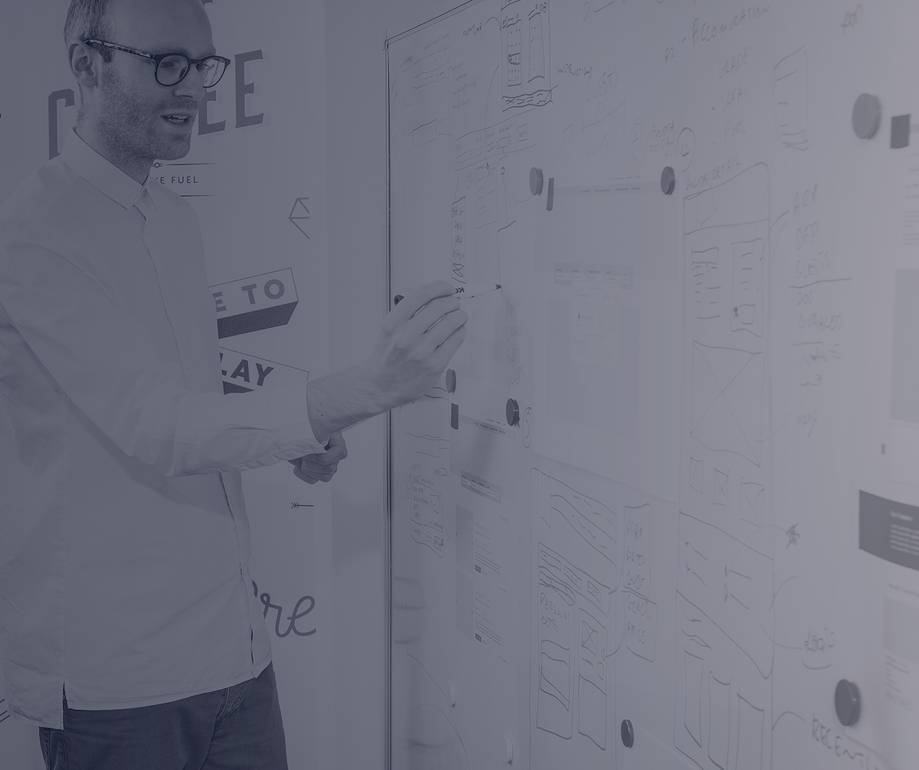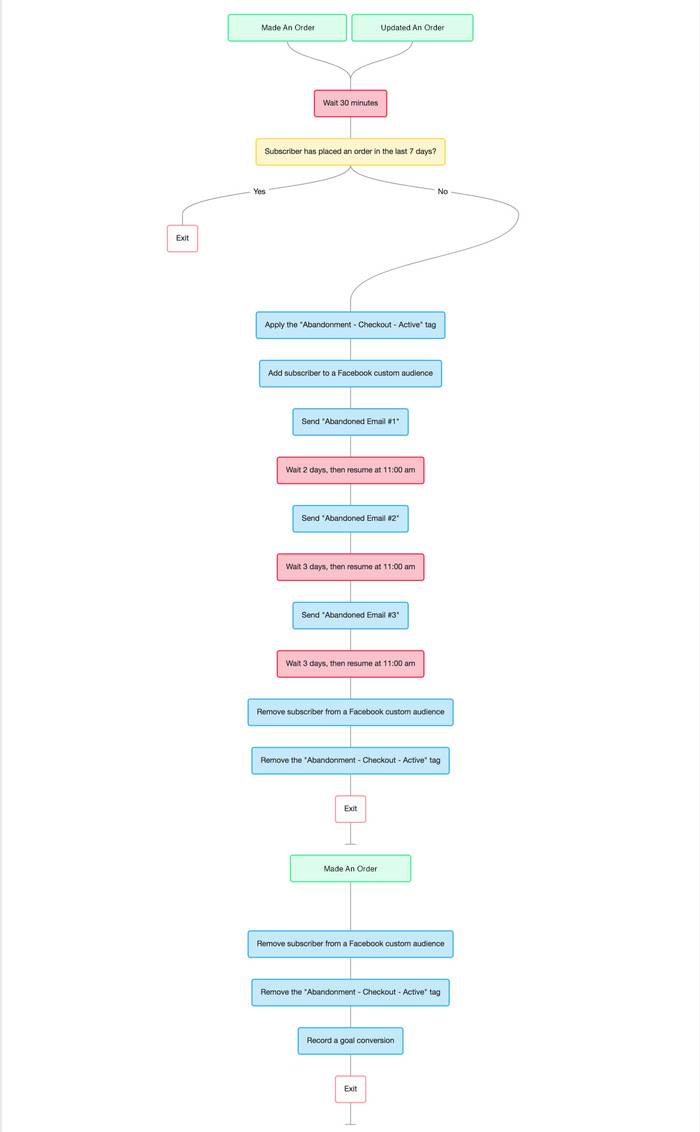Why you’re missing opportunities without marketing automations.
Workflows and automations are essentially a method to help minimise your manual input, whilst offering you the opportunity to tailor your marketing to specific user behaviours. The aim of marketing automation is to increase your relevance and therefore engagement.
Automations can run independently - based on how users interact with your business/website. For example - abandoned basket emails are sent automatically when a customer leaves your website.
Any decent marketing activity requires investment; whether that's time, money, or a combination of both, it requires a significant amount of input from you or your team to be effective. However, this up front investment is almost always worth the benefits that you can generate from it throughout the campaign.
An extra opportunity to plan out your campaign
Considering how your workflows should work, presents an opportunity for you to think about exactly how you want your campaign to work, and how your user should travel through it. This can range from being two to three touch points, all the way to 10, 20, 30+ touch points - it really depends on what you’re trying to achieve, and the type of campaign you’re running.
However, irrespective of the complexities of your campaign, thinking about it from a workflow point of view allows you to examine all the possible routes your customer could take throughout the campaign. This approach presents you with a whole host of opportunities that you can use to re-engage, up-sell and service your customer in a much more relevant manner.
In the same vein, it may also highlight some factors that you haven’t thought about yet which could help you avoid some awkward moments with your customers.
“There’s nothing worse than seeing a customer get 90% of the way through your conversion funnel, and then dropping out...”
Update: Since this blog was written, we now prefer to use the 'messy hexagon' model when describing a typical customer journey. Whilst the traditional 'AIDA' sales funnel stills holds value in some circumstances, we believe the messy hexagon provides an alternative and more realistic view of the customer's path to purchase.
Show me what it can do
As with anything, it’s important to get the foundations in place, and that means also looking at what platform you’re going to use to power all of this magic. There’s a whole range of different platforms available, but we’re big advocates (and agency partners) of Drip, so this article will be based on using them as the platform of choice.
There’s nothing worse than seeing a customer get 90% of the way through your conversion funnel, and then dropping out. So this workflow’s objective is to get them back into the funnel, to complete your desired action.
The below workflow is a great example of how you still need to cater for those that haven’t abandoned their cart, whilst creating a workflow to capture those that do. So, let’s break it down into more manageable chunks.
Phase 1
- Verify if this is an abandoned lead/sale first
The first check is two-fold; has a lead/sale been made, or has an lead/sale been started? After 30 minutes, that customer will then start traveling through the workflow where it then queries whether the customer has already converted within the last seven days.
Why do we do query that? This is a business decision, but for most businesses, it’s better etiquette to not push sales based marketing on someone who’s recently purchased. However, if they've not converted recently, we’ll move them down the funnel and apply the following steps:
- Tag them as an abandoned customer.
- Send that data to our Facebook audience, so that we’re using the same data sets and we can ensure we’re targeting the right people with the right messaging across multiple touch points.
- Start the first email campaign - this could simple be a reminder of what they’ve left in their basket, with a link to their cart to carry on their checkout process. You could create a sense of urgency here, and let them know this price will only be valid for 24 hours for example, to help incentivise the customer.
So part one of the workflow is complete, and it’s now a matter of waiting to see if they engage with your first email. All being well, they will, but we still need to have something in place if they don’t. Enter…
Phase 2
- We’ve waited two days and still no conversion from our workflow so far.
- So we send a second email, with slightly different messaging to see if we can entice the customer via other means. This could be in the form of a financial incentive for example, such as 10% off this order if you place it within 48 hours.
Three more days, and still nothing. It’s time to get specific...
Phase 3
We know this customer’s name and browsing habits, purchase history etc, so we know they’re a valid customer that’s invested in your brand previously. Therefore, in this instance, it could be due to an issue that’s not necessarily product based, but more customer based.
For example, they could simply be awaiting for pay day, or alternatively, they’re waiting for the weekend to try it on at their local store. This shouldn’t be considered a ‘lost opportunity’ - quite the opposite! So our third and final email will consist of content that is geared around promoting the following information:
- The customer’s local store, with information such as it’s address, contact information and opening hours.
- Let the customer know if this product is in stock at their local store or not. If not, show them an alternative product.
- Remind them of the payment options. If you offer finance solutions, lean on this to reduce the barrier of an upfront cost.
Understand the fine line between providing value to your customers, and overloading or irritating them
It’s important to remember though, that there has to be a clear cut off point to avoid annoying the customer - understand the fine line between providing value to your customers, and overloading or irritating them. For this example, phase three is their cut off point - where the business has to accept that the customer is simply not going to convert right now. That’s not to say they won’t convert in future, but they’re not going to on this particular opportunity.
Give your customers an exit route
While the above workflow is great, it’s important to not forget about all the customers that you do re-engage with throughout it, and end up converting - the main objective of this workflow. Those people need to be removed from this workflow once they’ve converted, to avoid marketing to them with totally irrelevant collateral.
As part of our workflow, we have a check in place that immediately removes the customer from this workflow as soon as you make a purchase. It goes like the following, and should look something similar to the image below:
- Remove customer from the Facebook audience we created at the beginning.
- Remove the tag of ‘abandoned customer’, and if you want, flag them as a customer if this is their first time.
- Record the conversion in Drip.
- Remove them from the workflow.
Sounds good - I want in!
We thought so - why wouldn't you? The above is just a simple example of how you can automate a crucial part of your marketing, giving you time to focus on other areas that do require a more manual process.
The best thing about getting something like this set up, is that it scales with your business. Have a sudden surge of customers due to another campaign, and you’ll likely get a lot more basket abandonments as part of an overall increase in sales. Having this workflow setup in advance, with the automations in place means that it’ll just ‘work’ to capture those additional opportunities.
Some other workflows that we consider to be crucial to your business include the following, and can all be automated with some planning and preparation before hand.
- Customer Re-engagement for lapsing customers
- Welcome/Onboarding processes
- Category/ Product intent
- Customer Feedback and reviews
- Post campaign follow up
- Customer Service based emails.
Want help applying this to your business to make the most out of your customers?
Get In Touch TodayPost by
Project




